英语教学法主要知识点
(完整版)英语教学法知识点整理
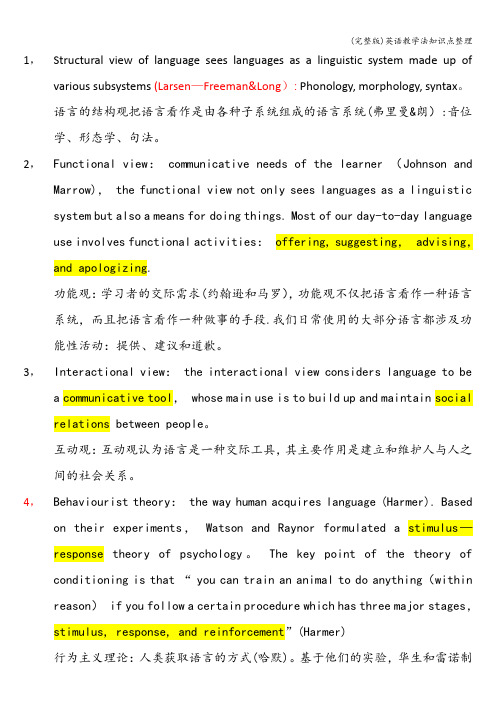
1,Structural view of language sees languages as a linguistic system made up of various subsystems (Larsen—Freeman&Long): Phonology, morphology, syntax。
语言的结构观把语言看作是由各种子系统组成的语言系统(弗里曼&朗):音位学、形态学、句法。
2,Functional view: communicative needs of the learner (Johnson and Marrow), the functional view not only sees languages as a linguistic system but also a means for doing things. Most of our day-to-day language use involves functional activities: offering, suggesting, advising,and apologizing.功能观:学习者的交际需求(约翰逊和马罗),功能观不仅把语言看作一种语言系统,而且把语言看作一种做事的手段.我们日常使用的大部分语言都涉及功能性活动:提供、建议和道歉。
3,Interactional view: the interactional view considers language to bea communicative tool, whose main use is to build up and maintain socialrelations between people。
互动观:互动观认为语言是一种交际工具,其主要作用是建立和维护人与人之间的社会关系。
4,Behaviourist theory: the way human acquires language (Harmer). Based on their experiments,Watson and Raynor formulated a stimulus—response theory of psychology。
英语教学法复习资料
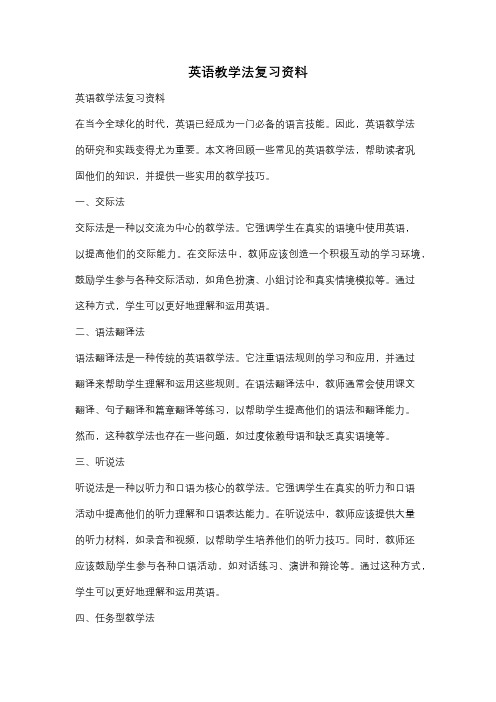
英语教学法复习资料英语教学法复习资料在当今全球化的时代,英语已经成为一门必备的语言技能。
因此,英语教学法的研究和实践变得尤为重要。
本文将回顾一些常见的英语教学法,帮助读者巩固他们的知识,并提供一些实用的教学技巧。
一、交际法交际法是一种以交流为中心的教学法。
它强调学生在真实的语境中使用英语,以提高他们的交际能力。
在交际法中,教师应该创造一个积极互动的学习环境,鼓励学生参与各种交际活动,如角色扮演、小组讨论和真实情境模拟等。
通过这种方式,学生可以更好地理解和运用英语。
二、语法翻译法语法翻译法是一种传统的英语教学法。
它注重语法规则的学习和应用,并通过翻译来帮助学生理解和运用这些规则。
在语法翻译法中,教师通常会使用课文翻译、句子翻译和篇章翻译等练习,以帮助学生提高他们的语法和翻译能力。
然而,这种教学法也存在一些问题,如过度依赖母语和缺乏真实语境等。
三、听说法听说法是一种以听力和口语为核心的教学法。
它强调学生在真实的听力和口语活动中提高他们的听力理解和口语表达能力。
在听说法中,教师应该提供大量的听力材料,如录音和视频,以帮助学生培养他们的听力技巧。
同时,教师还应该鼓励学生参与各种口语活动,如对话练习、演讲和辩论等。
通过这种方式,学生可以更好地理解和运用英语。
四、任务型教学法任务型教学法是一种以任务为导向的教学法。
它注重学生在解决实际问题的过程中学习和应用英语。
在任务型教学法中,教师应该设计一系列有挑战性的任务,以激发学生的学习兴趣和动机。
同时,教师还应该提供必要的语言支持和反馈,以帮助学生完成任务。
通过这种方式,学生可以更好地运用英语解决问题,并提高他们的学习效果。
五、多媒体教学法多媒体教学法是一种以多媒体技术为支持的教学法。
它通过使用电脑、投影仪和互联网等工具,提供丰富多样的学习资源,以帮助学生更好地理解和运用英语。
在多媒体教学法中,教师可以使用动画、音频和视频等多媒体材料,以增加学生的学习兴趣和参与度。
王蔷英语教学法重点

王蔷英语教学法重点王蔷教授的英语教学法是近年来备受推崇的一种教学方法。
它以语言习得理论为依据,通过为学生提供丰富的语言环境和多元化的教学策略,激发学生的学习兴趣和主动性,从而提高其英语水平和应用能力。
王蔷英语教学法强调学生的主体性和教师的主导性。
它认为,学生是语言学习的主体,应该主动参与到语言习得过程中。
而教师则应该扮演引导者和组织者的角色,为学生提供必要的学习资源和指导。
王蔷英语教学法还注重培养学生的语言综合应用能力。
它认为,语言是一种交际工具,学生应该在学习过程中掌握听、说、读、写、译等技能,并将其应用于实际生活中。
王蔷英语教学法认为,创造一个丰富的语言环境是提高学生英语水平的关键。
教师可以通过引入真实的语言材料、组织口语活动、播放英语视频等方式,为学生营造一个浓厚的英语学习氛围。
王蔷英语教学法提倡采用多元化的教学策略,以适应不同学生的学习风格和需求。
例如,教师可以采用小组合作、角色扮演、案例分析等教学方法,激发学生的学习兴趣和主动性。
王蔷英语教学法认为,培养学生的自主学习能力是至关重要的。
教师可以通过引导学生制定学习计划、评估学习成果等方式,帮助学生建立良好的学习习惯和自我管理能力。
王蔷英语教学法在实践中得到了广泛的应用,并取得了显著的效果。
许多研究表明,采用王蔷英语教学法的学生在英语水平和应用能力方面都有明显的提高。
这种教学方法也受到了广大教师和家长的欢迎和认可。
它不仅提高了学生的英语水平,还培养了他们的团队协作能力和自主学习能力。
王蔷英语教学法是一种先进、实用的教学方法。
它通过创造丰富的语言环境和多元化的教学策略,激发学生的学习热情和主动性,从而提高学生的英语水平和应用能力。
在未来的教育实践中,我们应该进一步探索和应用这种优秀的教学方法,为学生的全面发展提供更好的支持。
《英语教学法》是教育部普通高等教育“十一五”国家级规划教材,也是高等教育社的一本教材。
该教材的作者是王蔷教授,她是中国著名的英语教学法专家,拥有丰富的教学经验和深厚的学术背景。
英语教学法教程主要知识点归纳
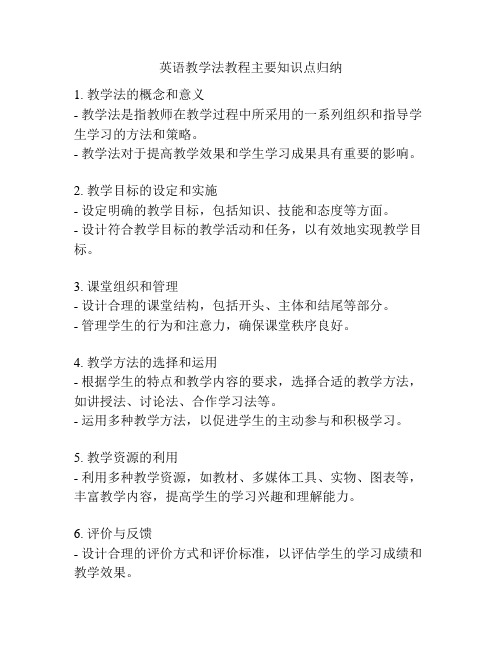
英语教学法教程主要知识点归纳
1. 教学法的概念和意义
- 教学法是指教师在教学过程中所采用的一系列组织和指导学生学习的方法和策略。
- 教学法对于提高教学效果和学生学习成果具有重要的影响。
2. 教学目标的设定和实施
- 设定明确的教学目标,包括知识、技能和态度等方面。
- 设计符合教学目标的教学活动和任务,以有效地实现教学目标。
3. 课堂组织和管理
- 设计合理的课堂结构,包括开头、主体和结尾等部分。
- 管理学生的行为和注意力,确保课堂秩序良好。
4. 教学方法的选择和运用
- 根据学生的特点和教学内容的要求,选择合适的教学方法,如讲授法、讨论法、合作学习法等。
- 运用多种教学方法,以促进学生的主动参与和积极学习。
5. 教学资源的利用
- 利用多种教学资源,如教材、多媒体工具、实物、图表等,丰富教学内容,提高学生的学习兴趣和理解能力。
6. 评价与反馈
- 设计合理的评价方式和评价标准,以评估学生的学习成绩和教学效果。
- 及时给予学生反馈,帮助他们纠正错误和进一步提高。
7. 多元化的教学策略
- 采用多种教学策略,如激发学生的兴趣和好奇心、引导学生
主动探究、启发学生的创造思维等,以提高教学效果。
8. 教学过程的设计和调整
- 设计完整的教学过程,包括课前导入、知识讲解、练习与巩固、课后复习等环节。
- 随时根据学生的学习情况和实际需要,调整教学过程和方法,以提高学习效果。
英语教学法教程主要知识点归纳
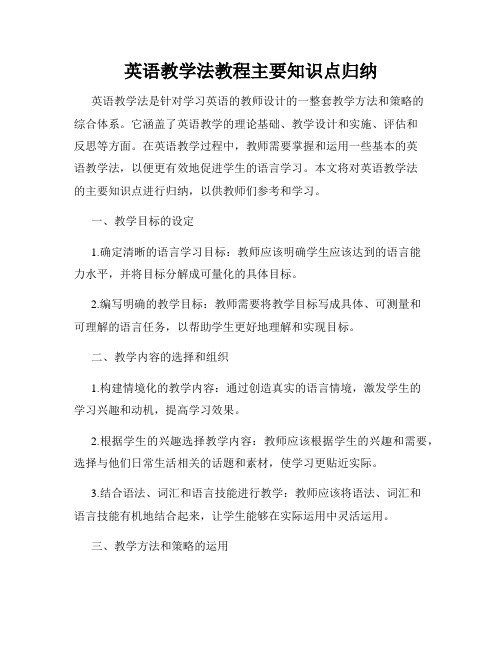
英语教学法教程主要知识点归纳英语教学法是针对学习英语的教师设计的一整套教学方法和策略的综合体系。
它涵盖了英语教学的理论基础、教学设计和实施、评估和反思等方面。
在英语教学过程中,教师需要掌握和运用一些基本的英语教学法,以便更有效地促进学生的语言学习。
本文将对英语教学法的主要知识点进行归纳,以供教师们参考和学习。
一、教学目标的设定1.确定清晰的语言学习目标:教师应该明确学生应该达到的语言能力水平,并将目标分解成可量化的具体目标。
2.编写明确的教学目标:教师需要将教学目标写成具体、可测量和可理解的语言任务,以帮助学生更好地理解和实现目标。
二、教学内容的选择和组织1.构建情境化的教学内容:通过创造真实的语言情境,激发学生的学习兴趣和动机,提高学习效果。
2.根据学生的兴趣选择教学内容:教师应该根据学生的兴趣和需要,选择与他们日常生活相关的话题和素材,使学习更贴近实际。
3.结合语法、词汇和语言技能进行教学:教师应该将语法、词汇和语言技能有机地结合起来,让学生能够在实际运用中灵活运用。
三、教学方法和策略的运用1.交互型教学方法:包括师生互动、学生间互动和学生自主学习,通过口语对话和实践活动培养学生的听说能力。
2.任务型教学方法:通过设置具体的任务来激发学生的学习兴趣和动力,培养学生的语言运用能力。
3.多媒体辅助教学:结合音频、视频和网络资源,提供多样化的教学材料和活动,增强学生的学习体验和参与度。
四、教学评估与反思1.形成性评价:通过课堂观察、作业评查和小组讨论等形式对学生进行及时的反馈和评估,帮助他们发现自己的差距并采取相应的学习策略。
2.总结性评价:通过考试、测验或教育性评估工具对学生的学习成果进行系统的评估,同时为教师提供改进教学的反馈。
五、教学环境的创设1.积极、鼓励的教学氛围:创造友好、开放、尊重和包容的教学环境,鼓励学生参与和表达,培养积极的学习态度。
2.多样化的学习资源:提供丰富多样的教学资源,包括教材、课外读物、在线学习平台等,满足学生的不同学习需求。
英语教学法教程主要知识点归纳
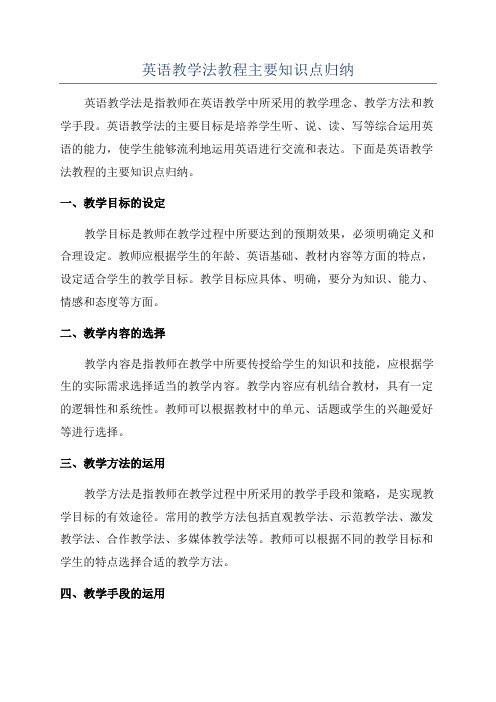
英语教学法教程主要知识点归纳英语教学法是指教师在英语教学中所采用的教学理念、教学方法和教学手段。
英语教学法的主要目标是培养学生听、说、读、写等综合运用英语的能力,使学生能够流利地运用英语进行交流和表达。
下面是英语教学法教程的主要知识点归纳。
一、教学目标的设定教学目标是教师在教学过程中所要达到的预期效果,必须明确定义和合理设定。
教师应根据学生的年龄、英语基础、教材内容等方面的特点,设定适合学生的教学目标。
教学目标应具体、明确,要分为知识、能力、情感和态度等方面。
二、教学内容的选择教学内容是指教师在教学中所要传授给学生的知识和技能,应根据学生的实际需求选择适当的教学内容。
教学内容应有机结合教材,具有一定的逻辑性和系统性。
教师可以根据教材中的单元、话题或学生的兴趣爱好等进行选择。
三、教学方法的运用教学方法是指教师在教学过程中所采用的教学手段和策略,是实现教学目标的有效途径。
常用的教学方法包括直观教学法、示范教学法、激发教学法、合作教学法、多媒体教学法等。
教师可以根据不同的教学目标和学生的特点选择合适的教学方法。
四、教学手段的运用教学手段是指教师在教学中所使用的具体工具和材料,有助于提高学生的学习效果和学习兴趣。
教学手段包括教学用具、多媒体设备、实物、图片、录音、录像等。
教师可以根据教学内容和学生的学习需求选择合适的教学手段。
五、教学评价的方法教学评价是指教师对学生学习情况和教学效果进行评估和判断的过程。
教学评价应注重全面、准确、客观和具体。
常用的教学评价方法包括测试、作业、观察、讨论、听说读写等。
教师可以根据教学目标和学生的实际情况选择合适的教学评价方法。
六、教学设计的步骤教学设计是指教师根据教学目标和教学要求所制定的教学过程和教学计划。
教学设计应包括教学目标、教学内容、教学方法、教学手段、教学评价等方面的内容。
教学设计的步骤包括分析教学内容和学生的学习需求、确定教学目标、设计教学过程和制定教学计划。
英语教学法期末知识点总结
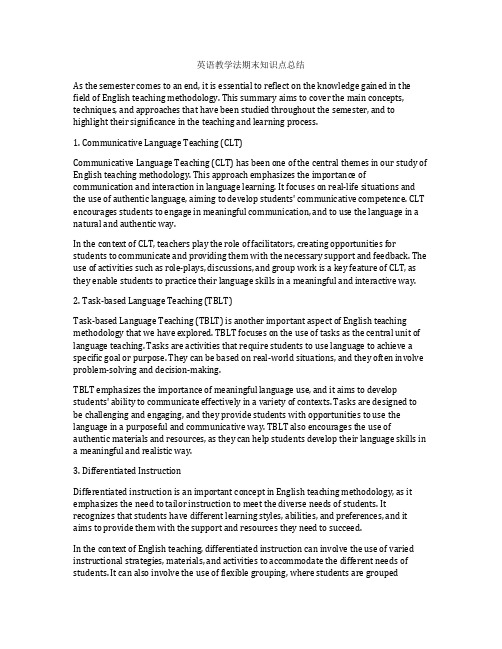
英语教学法期末知识点总结As the semester comes to an end, it is essential to reflect on the knowledge gained in the field of English teaching methodology. This summary aims to cover the main concepts, techniques, and approaches that have been studied throughout the semester, and to highlight their significance in the teaching and learning process.1. Communicative Language Teaching (CLT)Communicative Language Teaching (CLT) has been one of the central themes in our study of English teaching methodology. This approach emphasizes the importance of communication and interaction in language learning. It focuses on real-life situations and the use of authentic language, aiming to develop students' communicative competence. CLT encourages students to engage in meaningful communication, and to use the language in a natural and authentic way.In the context of CLT, teachers play the role of facilitators, creating opportunities for students to communicate and providing them with the necessary support and feedback. The use of activities such as role-plays, discussions, and group work is a key feature of CLT, as they enable students to practice their language skills in a meaningful and interactive way.2. Task-based Language Teaching (TBLT)Task-based Language Teaching (TBLT) is another important aspect of English teaching methodology that we have explored. TBLT focuses on the use of tasks as the central unit of language teaching. Tasks are activities that require students to use language to achieve a specific goal or purpose. They can be based on real-world situations, and they often involve problem-solving and decision-making.TBLT emphasizes the importance of meaningful language use, and it aims to develop students' ability to communicate effectively in a variety of contexts. Tasks are designed to be challenging and engaging, and they provide students with opportunities to use the language in a purposeful and communicative way. TBLT also encourages the use of authentic materials and resources, as they can help students develop their language skills ina meaningful and realistic way.3. Differentiated InstructionDifferentiated instruction is an important concept in English teaching methodology, as it emphasizes the need to tailor instruction to meet the diverse needs of students. It recognizes that students have different learning styles, abilities, and preferences, and it aims to provide them with the support and resources they need to succeed.In the context of English teaching, differentiated instruction can involve the use of varied instructional strategies, materials, and activities to accommodate the different needs of students. It can also involve the use of flexible grouping, where students are groupedaccording to their learning needs and preferences. By differentiating instruction, teachers can ensure that all students have the opportunity to learn and succeed, regardless of their individual differences.4. The Use of Technology in English TeachingThe use of technology has become an integral part of English teaching methodology. Technology can provide students with access to a wide range of resources and materials, and it can also enhance their learning experiences. In the context of English teaching, technology can be used to provide students with opportunities for independent practice, to facilitate communication and collaboration, and to provide access to authentic language use. In recent years, the use of technology in English teaching has expanded to include a wide range of tools and resources, including interactive whiteboards, multimedia resources, and online learning platforms. These technologies can provide students with engaging and interactive learning experiences, and they can also provide teachers with valuable resources for instruction and assessment.5. Assessment and Evaluation in English TeachingAssessment and evaluation are important components of English teaching methodology. They are essential for monitoring students' progress, providing feedback, and informing instructional decisions. In the context of English teaching, assessment can take many forms, including traditional tests and quizzes, as well as performance-based assessments and portfolios.In recent years, there has been an increasing emphasis on the use of authentic assessment in English teaching. Authentic assessment focuses on the assessment of real-life language use, and it aims to provide a more accurate and meaningful measure of students' language proficiency. Authentic assessment can include tasks and projects that require students to use the language in a purposeful and meaningful way, and it can provide a more accurate measure of students' ability to communicate effectively.In conclusion, the knowledge gained in the field of English teaching methodology has been extensive and diverse. The concepts, techniques, and approaches covered in this summary represent the key components of effective English teaching, and they highlight the importance of communicative, task-based, and differentiated instruction, the use of technology, and authentic assessment and evaluation in the teaching and learning process. By implementing these principles in the classroom, teachers can create engaging and effective learning experiences for their students, and they can help students develop the language skills they need to succeed in the real world.。
(完整word版)英语教学法教程知识点总结(1-12单元)

FLTM : foreign language teaching methodology is a science which studies the processes and patterns of foreign language teaching, aiming at revealing the natural and laws of foreign languages.Major approaches in FLT:Grammar-translation method (deductive演绎法)Direct method (inductive 概括法 )Audio-lingual methodHumanistic approaches: that emphasize the development of human values, growth in self-awareness and in the understanding of others, sensitivity to human feelings and emotions, andactive student involvement in learning and in the way human learning takes palaceThe silent waySuggestopediaCommunity language learning (CLL)Total physical response method (TPR)The natural approach(NA)The communicative approach (CA )An approach is a set of correlative assumptions dealing with the nature of language teaching ad leaning. Approach is axiomatic. It describes the nature of the subject matter to b taught.Method is an overall plan for the orderly presentation of language material, no part of which contradicts, and all of which is based upon, the selected approach. An approach is axiomatic, a method is procedural. Within one approach, there can be many methods.A technique is implementation---that which actually takes place in a classroom. It is a particular trick, stratagem, or contrivance used to accomplish an immediate objective. Techniques must b consistent with a method, and therefore I harmony with an approach as well.Views on language:Structural view : the structural view of language sees language as a linguistic system made up of various subsystems: the sound system (phonology); the discrete units of meaning produced by sound combinations (morphology); and the system of combining units of meaning for communication (syntax).Functional view : the functional view not only sees language as a linguistic system but also meansfor doing things. Functional activities: offering, suggesting, advising, apologizing, etc. International view: considers language to be a communicative tool, whose main use is to build up and maintain social relations between people. Therefore, learners not only need to know the grammar and vocabulary of the language but as importantly they need to know the rules for using them in a whole range of communicative contexts.Process-oriented theories: are concerned with how the mind organizes new information such as habit formation, induction, making inference, hypothesis testing and generalization. Condition-oriented theories : emphasize the nature of the human and physical context in which language learning takes place, such as the number of students, the kind of input learners receives, and the atmosphere.Behaviorist theory , the idea of this method is that language is learned by constant repletion and the reinforcement of the teacher. Mistakes were immediately corrected, and correct utterances were immediately praised.Cognitive theory, language is not a form of behavior, it is an intricate rule-based system and alarge part of language acquisition is the learning of this system.Constructivist theory, believes that learning is a process in which the learner constructs meaning based on his/her own experiences and what he/she already knows.Socio-constructivist theory, similar to constructivist theory, socio-constructivist theory emphasizes interaction and engagement with the target language in a social context based on theconcept of “Zone of Proximal Development”ZPD)( and scaffolding.Ethic devotion, professional qualities and personal styles CLT:communicative language teaching TBLT: task-based languageteachingThe goal of CLT is to develop students’communicative competence,which includes both the knowledge about the language and the knowledge about how to use the language appropriately in communicative situations. P16Hedge discusses five main components of communicative competence: linguistic competence, pragmatic competence, discourse competence, strategic competence, and fluency.Howatt proposes a weak and a strong version of CLT.Weak version: learners first acquire language as a structural system and then learn how to use it in communication. --- the weak version regards overt teaching of language forms and functions as necessary means for helping learners to develop the ability to use them for communication.Strong version: language is acquired through communication. The learners discover the structural system in the process of leaning how to communicate.---regards experiences of using the language as the main means or necessary conditions for learning a language as they provide the experience for learners to see how language is used in communication.Communicative activities: P24Tasks are activities where the target language is used by the leaner for a communicative purpose (goal) in order to achieve an outcome.Four components of a task: a purpose, a context, a process, and a productTasks focus on the complete act of communication.(Purposeful&contextualized communication). Exercises focus the students’attention on the individual aspects of language, such as vocabulary, grammar or individual skills. (Focus on individual language items) Exercise-task comes halfway between tasks and exercises, consists of contextualized practice of language item.PPP:for teaching a new structure-based lesson, content lesson, presentation (introduces new vocabulary and grammatical structures), practice(the lesson moves from controlled practice to guided practice and exploitation of the texts when necessary) and production(the students are encouraged to use what they are learned and practiced to perform communicative tasks)The importance of lesson planning: 1. an unprepared teacher begins of a disastrous lesson.2. An unprepared teacher receives less trust and cooperation from the students. 3. The students are different, the time is different, and the mood is different.Lesson Planning : is a framework of a lesson in which teachers make advance decisions aboutwhat they hope to achieve and how they would like to achieve it. In other words, teachers need to think about the aims to be achieved, materials to be covered, activities to be organized, and techniques and resources to be used in order to achieve the aims of the lesson.Principles for good lesson planning: aim, variety, flexibility, learnability, and linkage.Variety: planning a number of different students to a wide selection of materials never monotonous for the students.types of activities and where possible, introducing so that learning is always interesting, motivating andFlexibility: preparing some extra and alternative tasks and activities at the class does not always go according to the plan so that teachers always have the option to cope with the unexpected situations rather than being the slaves of written plans or one methodology. Learnability: within capability of the students, not be too easy or beyond or below the students’coping ability.Linkage : easy task followed by a comparatively difficult one, or do a series of language-focused activities to get the students prepared linguistically .Components of a lesson planning: background information, teaching aims, language content and skills, stages and procedures, teaching aids, assignments, and teacher’s after-lesson reflection.For skill-oriented lesson, focusing on developing skills, the model is applicable---pre-(reading), while-, post-. (Pre-step, while-step, post-step)Classroom management is the way teachers organize what goes on in the classroom.The role of the teacher: controller, assessor (evaluator, correcting mistakes and organizing feedback), organizer (organize and design task that students can perform in the class), prompter 推进者 (give appropriate prompts and give hints), participant, resource-provider, teacher’s new roles.There are rules to follow for making instructions effective.The first is to use simple instructions and make them suit the comprehensive level of thestudents.The second rule is to use the mother-tongue only when it is necessary.Give students time to get used to listening to English instructions and help the make aneffort to understand them.Use body language to assist understanding and stick to it each time you teach the class. Student grouping: whole class group—same activity at the same rhythm and pace, lockstep, pair work, group work, individual studyDiscipline: refers to a code of conduct which binds a teacher and a group of students together so that learning can be more effective.Questioning in the classroom:Classification of question types: 1.closed questions and open questions 2.display questions and Closed questions refer to those with only one s ingle correct answer while open questions may invite many different answers. Display questions are those that the answers are already knownto the teacher and they are used for checking if students know the answer, too. Genuine questions are questions which are used to find out new information and since they often reflect real context, they are more communicative. Lower-order questions refer to those that simple require recalling of information or memorization of facts while higher order questions require more reasoning, analysis, and evaluation.Simple question and difficult questionA mistake refers to a performance error that is either a random guess or an “a slip of tongue ”,it ’s a failure performance to a known system.An error has direct relation with the learners’language competence. Results from Lack of knowledgein the target language. Language error cannot be self-corrected no matter how much attention ispaidDealing with spoken errors: tasks or activities are focusing on accuracy or fluency. Balance between accuracy-based activities and fluency-based activities..When to correct: fluency work---not to interrupt, after the student’s performance; accuracy work---need to intervene moreHow to correct: direct teacher correction, indirect teacher correction, self-correction, peer correction, whole class correction.Goal of teaching pronunciation:Consistency: the pronunciation should be smooth and naturalIntelligibility : the pronunciation should be understandable t o the listenersCommunicative efficiency : the pronunciation should help convey the meaning that is intendedby the speaker.Aspects of pronunciation: besides sounds and phonetic symbols, such as stress (strong and weak form, word stress and sentence stress), intonation and rhythm (variation).Perception practice: using minimal pairs, which order, same or different? Oddand out, Completion.Production practice: listen and repeat, fill the blanks, make up sentences, use meaningful context, use picture, use tongue twisters.Grammar presentation: The deductive method, the inductive method, theguided discovery methodGrammar practice: mechanical practice and meaningful/ communicative practice.Mechanical practice: involves activities that are aimed at form accuracy. Students pay repeated attention to a key element in a structure. Substitution drill and transformation drills.Meaningful practice: focus on the production, comprehension or exchange of meaning though the students keep an eye on the way newly learned structures are used in the process. It comes after mechanical practice. (Comparatives and superlatives). Using picture prompts, using mimes or gestures as prompts, using information sheet as prompts, using key phrases or key words as prompts, using chained phrases for story telling, using created situations.What does knowing a word involve? Denotative meaning; connotative meaning;chunk/collocations; synonyms, antonyms and hyponyms; receptive and productive vocabulary.Denotative meaning of a word or a lexical item refers to those words that we use to label thingsas regards real objects, such as a name or a sign, etc. in the physical world. Primary meaning ofa word.A connotative meaning of a word refers to the attitudes or emotions of a language user in choosinga word and the influence of these on the listener or reader ’s interpretation of the word.Collocations refer to words that co-occur with high frequency and have been accepted as waysfor the use of words. For instance, see, look at, watch.Hyponyms refer to words which can be grounded together under the same superordinate concept. Receptive/passive vocabulary refers to words that one is able to recognize and comprehend in reading or listening but unable to use automatically in speaking or writing. Those words that oneis not only able to recognize but also able to use in speech and writing are considered as one’s productive/active vocabulary.Ways of presenting vocabulary: inductive and deductive.Ways of consolidating vocabulary: labeling; spot the difference; describe and draw; play a game; use words series; word bingo; word association; finding synonyms and antonyms; categories; using word net-work; using the internet resources for more ideas.Developing vocabulary learning strategies: review regularly, guess meaning from context, organize vocabulary effectively, use a dictionary, and manage strategy use.Principles and models for teaching listening: focus on process, combine listening with other skills (listening can be practice with not-taking, and answers, role plays, retelling, interviewing, discussions, or a writing task), focus on the comprehension of meaning, grade difficulty level appropriately, principles for selecting and using listening activities.Two approaches are frequently used to describe different processes of listening.Bottom-up model and Top-down model.Bottom-up model:从细节下手start with sound and meaning recognitions. Listeners construct meaning of what they hear based on the sound they hear, expect the listeners have a very effective short-term memory as they have to make sense of every sound in order to figure out the meaningof words, phrase, and structures. If there are unfamiliar sounds, listeners will find it very difficultto keep up with speaker. --- recognizing sounds of words, phrases or structures.Top-down model: 侧重纲要listening for gist and making use of the contextual clues and background knowledge to construct meaning are emphasized. Listeners can understand better if they already have some knowledge in their mind about the topic. Such knowledge is also termedas prior knowledge or schematic knowledge---mental frameworks for various things and experience we hold in our long-term memory. ---referring meaning from broad contextual clues and background knowledge.Three teaching stages: pre-listening—warming up; while-listening---listening comprehension; post-listening---checking answers.Teaching speakingLess complex syntax, short cuts, incomplete sentences, devices such as fillers, hesitation device to give time to thinking before speaking, false start, spontaneous, time-constraint.Types of speaking:pre-communicative activities— mechanical activities; communicative activities---meaningful activities.Controlled activities, semi-controlled activities, communicative activities: Information-gap activities; dialogues and role-plays; activities using pictures; problem-solving activities; change the story; human scrabbleOrganizing speaking tasks: use small group workTeaching readingThe construction of meaning from a printed or written message.Two broad levels in the act reading.1). A recognition task of perceiving visual signals from the printed page through the eyes.2). A cognitive task of interpreting the visual information revealing the received information withthe reader’s own general knowledge, and reconstructing the meaning that the writer had meantto convey.For teaching: intensive/extensive readingIn terms of methods: skimming/scanning/predictingFor reading practice: reading aloud/silent readingThe role of vocabulary in reading: sight vocabulary : words that one is able to recognize immediately are often referred to as sight vocabulary.Principles and models for teaching reading : bottom-up model; top-down model; interactive modelPre-reading activities: predicting (predicting based on the tile/ based on vocabulary/basedon the T/F questions) setting the scene, skimming, and scanningWhile-reading activities: TD (a transition device)Reading comprehension questions: 1. questions of literal comprehension 2. Questions involving reorganization or reinterpretation 3. Questions for inference (what is implied but not explicitly stated) 4. questions for evaluation or appreciation(making judgment about what the writer is trying to do and how successful he/she is in achieving his/her purpose) 5. Questions for personal responseIntensive reading is an accuracy-oriented activity involving reading for detail; the main purpose is to learn language embedded in the reading texts, which are usually short. Extensive reading is a fluency activity. The main purpose is to achieve global understanding. Te reading texts usually contains less new vocabulary and is longer than those intended for intensive reading.Teaching writingWriting for consolidating language, writing for communication, between writing for learning and writing for communication, imaginationNot have a real communicative purpose; for language skill; a little bit communicative; communicative approach; neither restrictions in contents nor in word limit; more communicative; more motivatedCA: communication approachA Productive approach to writing成就法/a prose model approach---fruitlessA Processapproach to writing 过程法 : The teacher provides to guide students through the process that they undergo when they are writing. This kind of guidance should be gradually withdrawn so that the students can finally become independent writers.Main procedures of processwriting include: creating a motivation to write, brainstorming, mapping, freewriting, outlining, drafting, editing, revising, proofreading and conferencing.。
教师资格证科目三-英语教学法知识点整理
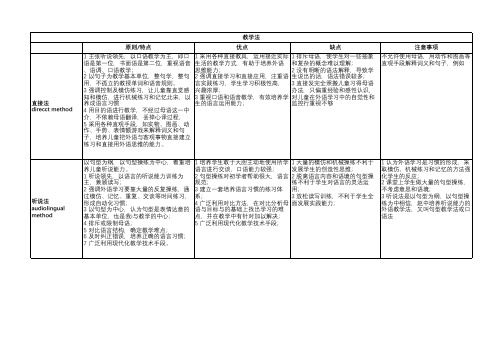
主,兼顾读写;
规范;
练不利于学生对语言的灵活运
2 强调外语学习要靠大量的反复操练,通 3 建立一套培养语言习惯的练习体 用;
过模仿、记忆、重复、交谈等时间练习, 系;
3 放松读写训练,不利于学生全
形成自动化习惯;
4 广泛利用对比方法,在对比分析母 面发展实践能力;
3 以句型为中心,认为句型是表情达意的 语与目标与的基础上找出学习的难
过程分为感知、理解、练习和活用四个步 能力;
骤;
4 不使用母语,通过实物、图片、手势等
直观手段直接教外语,使情景的意义与所
学的外语建立联系;
5 坚持口语领先和句子本位的原则,日常
生活情景对话使教学的中心,掌握正确的
语音、语调和口语语感;
6 广泛使用现代化技术设备,使儿童充分
运用视觉感官和听觉器官进行学习;
1 意义是第一位的; 2 课堂任务需要有明确的目标,即解决某 一交际问题; 3 活动的成果是可以被检验的; 4 任务应与真实世界和生活经验联系
任务型教学法 task-based language teaching approach
1 完成多种多样的任务活动,有助于 1 概念不清;
激发学生的学习兴趣;
听说法 audiolingual method
以句型为纲,以句型操练为中心,着重培 1 培养学生敢于大胆主动地使用所学 1 大量的模仿和机械操练不利于
养儿童听说能力。
语言进行交谈,口语能力较强; 发展学生的创造性思维;
1 听说领先,以语言的听说能力训练为 2 句型操练对初学者帮助很大,语言 2 脱离语言内容和语境的句型操
系性;
的言语,而且是根据功确定不同的目标,教
学活动的练习形式多样,采用二人、三人
英语教学法王蔷笔记

英语教学法王蔷笔记摘要:1.英语教学法的重要性2.王蔷的英语教学理念3.王蔷笔记的主要内容4.王蔷笔记对英语教学的贡献正文:英语教学法是英语教育领域中的一个重要分支,它研究如何有效地教授英语,如何提高学生的英语学习效率,以及如何帮助学生更好地掌握和运用英语。
在我国,英语教学法的研究和实践一直受到广泛的关注和重视。
其中,王蔷教授的英语教学法理念和笔记,对于我国的英语教学有着重要的影响和贡献。
王蔷教授是我国著名的英语教育专家,她主张以学生为中心,注重培养学生的英语语言运用能力,强调语言学习的实践性和实用性。
王蔷教授认为,英语教学应该注重语言的实际运用,而不仅仅是语法和词汇的学习。
因此,她提倡通过听说读写的实践活动,让学生在真实的语境中体验和学习英语。
王蔷笔记是王蔷教授多年英语教学实践经验的总结和提炼,它包括了丰富的教学方法和技巧,以及实用的教学理论和原则。
王蔷笔记的主要内容包括:以学生为中心的教学理念,注重语言实践的教学方法,以及有效的教学评价方式等。
这些内容对于英语教学具有重要的指导意义,能够帮助教师更好地进行英语教学,提高学生的学习效果。
王蔷笔记对我国的英语教学有着重要的贡献。
首先,它提出了以学生为中心的教学理念,这一理念已经成为我国英语教学的主流理念,对于提高学生的学习积极性和学习效果有着重要的作用。
其次,王蔷笔记强调语言实践的重要性,这一观点推动了我国英语教学从重语法、重词汇向重实践、重运用的转变,对于提高学生的语言运用能力有着重要的影响。
最后,王蔷笔记提出了有效的教学评价方式,这一方式能够更准确地评价学生的学习效果,对于提高教学质量和效果有着重要的作用。
英语教学法归纳
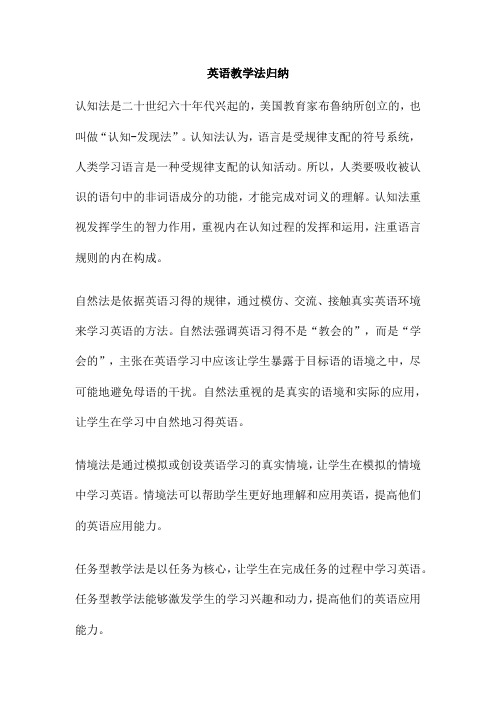
英语教学法归纳认知法是二十世纪六十年代兴起的,美国教育家布鲁纳所创立的,也叫做“认知-发现法”。
认知法认为,语言是受规律支配的符号系统,人类学习语言是一种受规律支配的认知活动。
所以,人类要吸收被认识的语句中的非词语成分的功能,才能完成对词义的理解。
认知法重视发挥学生的智力作用,重视内在认知过程的发挥和运用,注重语言规则的内在构成。
自然法是依据英语习得的规律,通过模仿、交流、接触真实英语环境来学习英语的方法。
自然法强调英语习得不是“教会的”,而是“学会的”,主张在英语学习中应该让学生暴露于目标语的语境之中,尽可能地避免母语的干扰。
自然法重视的是真实的语境和实际的应用,让学生在学习中自然地习得英语。
情境法是通过模拟或创设英语学习的真实情境,让学生在模拟的情境中学习英语。
情境法可以帮助学生更好地理解和应用英语,提高他们的英语应用能力。
任务型教学法是以任务为核心,让学生在完成任务的过程中学习英语。
任务型教学法能够激发学生的学习兴趣和动力,提高他们的英语应用能力。
全身反应法是通过身体动作等方式来学习英语。
全身反应法能够帮助学生更好地理解和记忆英语,同时能够提高他们的学习兴趣和参与度。
交际法是以交际为核心,让学生在交际中学习英语。
交际法重视的是学生的主动性和参与性,让学生在真实的交际环境中学习和应用英语。
以上六种教学法都有其独特的特点和适用范围,教师在教学过程中应该根据不同的教学需求和学生的特点选择合适的教学法来进行教学。
高中英语句型是英语学习的重要部分,掌握好这些句型可以帮助我们更好地理解英语语法,提高英语口语和写作能力。
下面是一些常见的高中英语句型归纳:这种句型通常用来表示行为或状态的基本情况或正在进行的动作。
例如:The sun is shining.(太阳正在照耀。
)这种句型表示行为或状态的结果,即主语对宾语产生了某种影响或结果。
例如:I like music.(我喜欢音乐。
)这种句型表示主语对两个宾语都产生了影响或结果。
英语教学法王蔷笔记

英语教学法王蔷笔记摘要:一、王蔷《英语教学法教程》概述二、英语学习的基本方法1.语言与学习的的关系2.学习语言的个体差异三、英语教学方法及步骤1.制定明确的教学目标2.情景教学法的应用3.常见英语教学方法的介绍四、总结与展望正文:一、英语学习的基本方法1.语言与学习的的关系语言是人类交流的基本工具,学习语言是一个持续的过程。
个体通过与他人的互动、参与各种语言活动,逐渐掌握语言技能。
2.学习语言的个体差异不同的人在学习语言过程中,由于认知能力、学习动机、语言环境等因素的不同,呈现出个体差异。
教师应关注学生的个性化需求,制定因材施教的教学策略。
二、英语教学方法及步骤1.制定明确的教学目标教学目标是课堂教学的出发点和回归点。
教师应根据学生的实际情况,制定具体、明确的教学目标,确保教学过程的有效性。
2.情景教学法的应用情景教学法是一种以生活场景为依托的教学方法。
教师应创设真实、生动、实用的情景,帮助学生将所学语言材料进行综合、创造性地表达交流。
3.常见英语教学方法的介绍(1)Task-Based Language Teaching(TBLT):以任务为导向的教学方法,强调学生在完成任务的过程中自然地学习语言。
(2)五步教学法:包括引入、练习、输出、反馈和巩固五个步骤,逐步引导学生掌握语言技能。
(3)五指教学法:一种针对听、说、读、写、译五个语言技能的教学方法,注重均衡发展学生的语言能力。
(4)3P教学法:包括呈现、实践、产出的教学过程,强调在实践中学习语言。
(5)交际型教学:以培养学生的交际能力为核心,注重语言运用的实际场景。
三、总结与展望王蔷的《英语教学法教程》为英语教师提供了丰富的教学理论和实践方法。
通过关注学生的个体差异、制定明确的教学目标,以及运用多样的教学方法,教师可以提高英语教学质量,培养学生的语言交际能力。
英语教学法复习提纲

英语教学法复习提纲
一、背景概述
1.英语教学研究的历史背景
2.英语教学法的定义和意义
二、教学目标和教材分析
1.教学目标的分类和设定
2.教材的选择和分析
3.教学资源的利用与教材的补充
三、教学法的基本原则和分类
1.教学法的基本原则
2.传统教学法与现代教学法的比较
3.教学法的分类及其特点
四、课程设计的原则和步骤
1.课程设计的基本原则
2.课程设计的步骤和要点
3.教学设计的实例分析
五、教学方法与教学技巧
1.教学方法的选择和应用
2.意义互动教学方法的实施
3.教学技巧的训练与应用
六、评估与反馈
1.评估的概念和种类
2.教学评估的重要性和方法
3.反馈的意义和方法
七、多媒体技术在英语教学中的应用
1.多媒体技术的发展与应用
2.多媒体教学的优势和挑战
3.多媒体教学案例分析
八、教学评价和自我提升
1.教学评价的概念和目的
2.教师自我提升的途径和方法
3.教学反思和改进的实践
九、教学实践总结和启示
1.教学实践的经验总结
2.教学实践对教师职业发展的启示
3.未来英语教学的发展趋势
以上是针对英语教学法复习的提纲,可以根据自己的需要进行有针对性的复习和整理。
为了更好地掌握和应用英语教学法,建议在复习时结合实际案例和实践进行深入研究。
英语教学法王蔷第二版unit18笔记
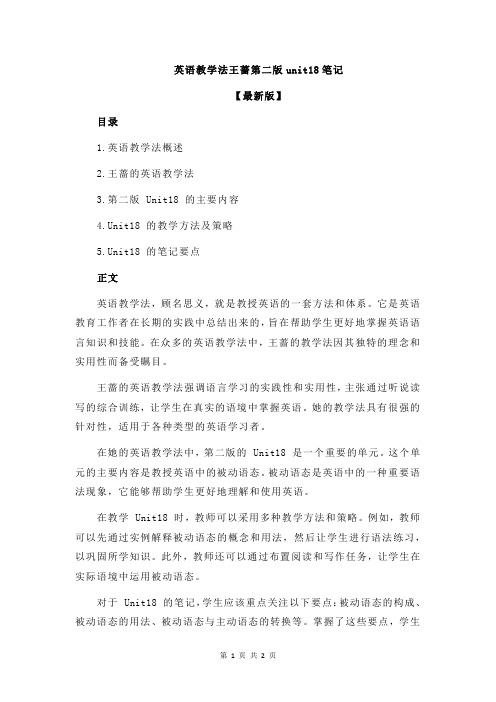
英语教学法王蔷第二版unit18笔记
【最新版】
目录
1.英语教学法概述
2.王蔷的英语教学法
3.第二版 Unit18 的主要内容
4.Unit18 的教学方法及策略
5.Unit18 的笔记要点
正文
英语教学法,顾名思义,就是教授英语的一套方法和体系。
它是英语教育工作者在长期的实践中总结出来的,旨在帮助学生更好地掌握英语语言知识和技能。
在众多的英语教学法中,王蔷的教学法因其独特的理念和实用性而备受瞩目。
王蔷的英语教学法强调语言学习的实践性和实用性,主张通过听说读写的综合训练,让学生在真实的语境中掌握英语。
她的教学法具有很强的针对性,适用于各种类型的英语学习者。
在她的英语教学法中,第二版的 Unit18 是一个重要的单元。
这个单元的主要内容是教授英语中的被动语态。
被动语态是英语中的一种重要语法现象,它能够帮助学生更好地理解和使用英语。
在教学 Unit18 时,教师可以采用多种教学方法和策略。
例如,教师可以先通过实例解释被动语态的概念和用法,然后让学生进行语法练习,以巩固所学知识。
此外,教师还可以通过布置阅读和写作任务,让学生在实际语境中运用被动语态。
对于 Unit18 的笔记,学生应该重点关注以下要点:被动语态的构成、被动语态的用法、被动语态与主动语态的转换等。
掌握了这些要点,学生
就能够更好地理解和使用被动语态。
总的来说,王蔷的英语教学法以其独特的教学理念和实用的教学方法,为我国的英语教育做出了重要的贡献。
英语教学法主要知识点
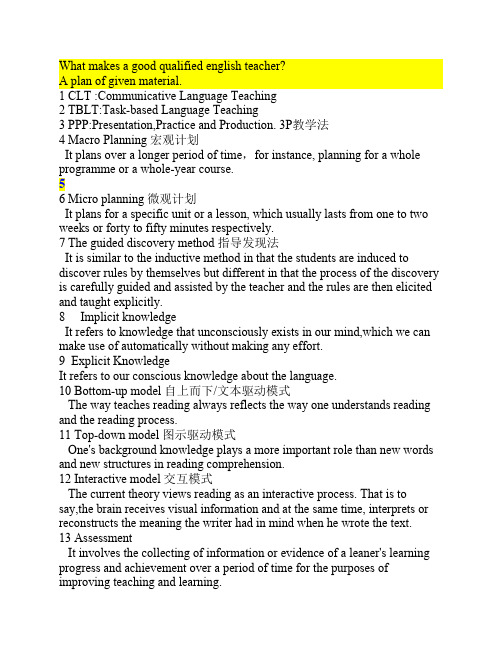
What makes a good qualified english teacher?A plan of given material.1 CLT :Communicative Language Teaching2 TBLT:Task-based Language Teaching3 PPP:Presentation,Practice and Production. 3P教学法4 Macro Planning 宏观计划It plans over a longer period of time,for instance, planning for a whole programme or a whole-year course.56 Micro planning 微观计划It plans for a specific unit or a lesson, which usually lasts from one to two weeks or forty to fifty minutes respectively.7 The guided discovery method 指导发现法It is similar to the inductive method in that the students are induced to discover rules by themselves but different in that the process of the discovery is carefully guided and assisted by the teacher and the rules are then elicited and taught explicitly.8 Implicit knowledgeIt refers to knowledge that unconsciously exists in our mind,which we can make use of automatically without making any effort.9 Explicit KnowledgeIt refers to our conscious knowledge about the language.10 Bottom-up model 自上而下/文本驱动模式The way teaches reading always reflects the way one understands reading and the reading process.11 Top-down model 图示驱动模式One's background knowledge plays a more important role than new words and new structures in reading comprehension.12 Interactive model 交互模式The current theory views reading as an interactive process. That is to say,the brain receives visual information and at the same time, interprets or reconstructs the meaning the writer had in mind when he wrote the text.13 AssessmentIt involves the collecting of information or evidence of a leaner's learning progress and achievement over a period of time for the purposes of improving teaching and learning.14 Sight Vocabulary 即识词汇Words that one is able to recognise immediately are often referred to as sight vocabulary.In other words, your sight vocabulary will be those words that you can recognise with both sounds and meanings without special effort from your brain.15 Information Gap信息沟16 Portfolio学习文件夹成长记录袋It is a purposeful collection of materials assembled over a period of time by a learner to provide evidence of skills,abilities and attitudes related to their study.17 Mechanical PracticeIt involves activities that are aimed at form accuracy.18 Meaningful PracticeIt focus on the production,comprehension or exchange of meaning though the students ' keep an eye on ' the way newly learned structures are used in the process.19 Criterion-referenced assessmentCriterion-referenced language assessment is based on a fixed standard or a set criterion.20 Norm-referenced assessmentIt is designed to measure how the performance of a particular student or group of students compares with the performance of another students or group of students whose scores are given as the norm.21 On -the-use evaluationIt means the evaluation which is carried out independent of its users or before it gets into the classroom.22 In-the-use evaluationFor in-the-use evaluation,evaluation is done based on the user's opinions about how useful and effective it is for promoting learning.1 What is the communicative competence?It includes both the knowledge about the language and the knowledge about how to use the language appropriately in communicative situations.2 Principles of CLTmunicative principle:Actives that involve real communication promote learning.B.Task principle:Activities in which language is used for carrying out meaningful tasks promote learning.C. Meaningfulness principle: language that is meaningful to the learner supports the learning process.3 The 6 orientation for evaluating the communicative classroom acting.A. Communicative purpose:The activity must involve the students in performing a real communicative purpose rather than just practising language for its own sake. 目的B. Communicative desire:The activity must create a desire to communicate in the students. 交际欲望C. Content,not form:When the students are doing the activity, they must be concentrating on what they are saying,not how they say it.有内容,不是考虑形式D. Variety of language: The activity must involve the students in using a variety of language,not just one specific language form.E. No teacher intervention:The activity must be designed to be done by the students working by themselves rather than with the teacher.干涉F. No materials control: The activity should not be designed to control what language the students should use.4 Four components of the taskA. A purpose: making sure the students have a reason for undertaking the taskB. A contact: this can be real,simulated or imaginary,and involves sociolinguistic issues such as the location, the participants and their relationship,the time,and other important factorsC. A process:getting the students to use learning strategies such as problem solving reasoning,inquiring, conceptualising and communicating.D. A product: there will be some form of outcome, either visible or invisible.5 Principles for good lesson planningA. Aim. It means the realistic goals for the lesson.B. Variety. It means planning a number of different types of activities and where possible,introducing students to a wide selection of materials so that learning is always interesting,motivating and never monotonous for the students.C. Flexibility. It means preparing some extra and alternative tasks and activities so that teachers have the options to cope with the unexpected situations rather than being the slaves of written plans or one methodology.D. Learnability. It means the contents and tasks planned for the lesson should be within the learning capability of the students.E. Linkage. It means the stages and steps within each stage are planned in such a way that they are someway linked with one another.6 Measures for indisciplined actsA. Act immediately. If possible, indisciplined acts should be immediately stopped so that less damage is made.B. Stop the class. If the indiscipline hinder the progress of the whole class, the teacher should stop the class and make it clear what is wrong.C. Rearrange the seats. If students are moved to the front of the class they will behave better.D. Change the activity.E. Talk to students after class. If a student is continually making trouble, the teacher should talk to that student after class.F. Create a code of behaviour. It means the teacher and students can work together to create some basic rules for the class during activities.7 How to deal with errorsA. Make a distinction between an error and a mistake. A mistake refers to a performance error that is either a random guess or a ' slip of tongue ', and it is a failure performance to a known system. An error has direct relation with the learners' language competence.B. Dealing with spoken errorsC. Choose proper time to correctD. How to correct. Avoid damaging students' self esteem and confidence.8 Goal of teaching pronunciationA. Consistency:the pronunciation should be smooth and natural.B. Intelligibility:the pronunciation should be understandable to the listeners.C. Communicative efficiency:the pronunciation should help convey the meaning that is intended by the speaker.9 What does it mean to know a word.A. It means knowing its pronunciation and stressB. Knowing its spelling grammatical propertiesC. Knowing its meaningD. Knowing how and when to use it to express the intended meaning.10 Ways of presenting vocabularyA. Try to provide visual or physical demonstration whenever possible, using pictures, photos, video clips, mime or gestures to show meaning.B. Provide a verbal context to demonstrate meaning.C. Use synonyms or antonyms to explain meanings.D. Use lexical sets or hyponyms to show relations of words and their meanings.E. Translate and exemplify,especially with technical words or words with abstracts meaning.F. Use word formation rules and common affixes to build new lexical knowledge on what is already known.G. Teach vocabulary in chunks.H. Think about the context in real life where the word might be used.I. Think about providing different context for introducing new words.J. Prepare for possible misunderstanding or confusion that students may have.11 Principles for teaching speakingA. Balancing accuracy-based with fluency-based practices.B. Contextualising practiceC. Personalising practiceD. Building up confidenceE. Maximising meaningful interactionsF. Helping students develop speaking strategiesG. Making the best use of classroom learning environment to provide sufficient language input and practice for the students12 The main procedures of process writingA. Creating a motivation to writeB. Brainstorming,C. MappingD. FreewritingE. OutliningF. DraftingG.editingH. RevisingI. ProofreadingJ.conferencing13 Methods for assessmentA. Summative and formative assessmentB. Teacher's observationsC. Continuous assessmentD. Self-assessment and peer assessmentE. Project work学习日志F. Portfolios学习文件夹成长记录袋14 intelligence。
英语教学法重点

英语教学法重点英语教学法重点Unit 1 Language and Learning1.1 How do we learn languageWe learn language at different agesPeople have different experiencesPeople learn languages for different reasonsPeople learn languages in different waysPeople have different capabilities in language learning Learning can be affected by the way how language is taught Learning is affected by the degree of success one is expect to achieve.Thus the challenge confronting language teaching is how teachingmethodology can ensure successful learning by all the learners who havemore differences than the commonality.1. 2 What are the major views of language?1) Structural view:Language is a linguistic system made up of various subsystems: phonology, morphology, lexicology and syntacx. To learn a language isto learn its vocabulary and structural rules.英语教学法重点2) Functional view:Language is a linguistic system as well as a means for doing things.Learners learn a language in order to be able to do things with it (useit). To perform functions, learners need to know how to combine thegrammatical rules and the vocabulary to express notions that performthe functions.3) Interactional view:Language is a communicative tool to build up and maintain social relations between people. Learners need to know the rules of a languageand where, when and how it is appropriate to use them.1.3Views on Language LearningTwo broad learning theories:Process-oriented theories are concerned with how the mind organizesnew information.Condition-oriented theories emphasize the nature of human and physical context.Behaviorist theoryB. F. Skinner?英语教学法重点A stimulus-response theory of psychology?Audio-lingual method?The idea of this method is that language is learned by constant ?repetition and the reinforcement of the teacher. Mistakes wereimmediately corrected, and correct utterances were immediately praised.Cognitive theory B.Influenced by Noam Chomsky (revival of structural linguistics)?Language as an intricate rule-based system?produce to him A learner acquires language competence which enables ?language.One influential idea of cognitive approach to language teaching ?is that students should be allowed to create their own sentence basedon their own understanding of certain rules.Constructivist theory C.Jean Piaget (1896—1980)?The learner constructs meaning based on his/her own experiences ?and what is already known.Socio-constructivist theory D.英语教学法重点Vygotsky?“Zone of Proximal Development” (ZPD); scaffolding (脚手架)?Learning is best achieved through the dynamic interaction between ?the teacher and the learner and between learners.1.4 What are the qualities of a good language teacher?A good language teacher does not solely depend on his/her commandof the language. There are a variety of element that contributes to thequalities of a good language teacher. These element can be categorizedinto three groups:ethic devotion, professional quality and personalstyles.1.5 How can one become a good language teacher?Wallace's (1991) ‘reflective model' (Figure 1.1, p.9)?英语教学法重点Stage 1: language developmentStage 2: learning, practice, reflectionThe learning stage is the purposeful preparation that a languagenormally receives before the practice,This preparation can include:1. Learning from others' experience2. Learning the received knowledge3. Learning from one's own experiencesThe practice stage (2 senses)?Pseudo practice: short period of time assigned to do teaching practice as part of one's pre-service education, usually under the supervision of instructorsThe real classroom teaching: what a teacher undertakes after he/she finishes formal educationTeachers benefit from practice if they keep on reflecting on ?what they have been doingGoal: professional competenceUnit 2 Communicative Principles and Task-based language teaching英语教学法重点2.1 How is language learned in classrooms different from languageused in real life?Language used in real lifeLanguage taught in the classroomTo focus on forms (structures or T o perform certaincommuntcative patterns)functionsUse all skills, both receptive To focus on one or two language skills skills and ignore others. and productive skillsUsed in a certain context T o isolate language from itscontext2.2 What is communicative competence?To bridge the gap between classroom language teaching and real-lifelanguage use, one solution is to adopt CLT, the goal of which is todevelop students' communicative competence.Definition:Communicative competence include both the knowledge about the language and the knowledge about how to use the language appropriatelyin communicative situationsFive components of communicative competence (Hedge 2000) Linguistic competence (语言能力)?The knowledge of language itself, its form and meaning.Pragmatic competence (语用能力)?英语教学法重点The appropriate use of language in social context.Discourse competence (语篇能力)?One's ability to create coherent written text or conversation and the ability to understand themStrategic competence (策略能力)?Strategies one employs when there is communication breakdown due to lack of resources.Fluency(流利性)?One ‘s ability to ‘link units of speech together withfacility and without strain or inappropriate slowness or undue (过分的,不适当的) hesitation'2.3Implications for teaching and learningTeaching must enable learners to grasp the five components of communicative competence, but not just the linguisticcompetence.2.4 Principles of CLTThree principles suggest by Richard and Rodgers:1 Communication principle:involve real communication2 Task principle:Carry out meaningful tasks英语教学法重点3 Meaningfulness principle:Meaningful language to the learner Howatt proposes a weak and a strong version of CLT:。
英语教学法教程知识点总结(1-12单元)
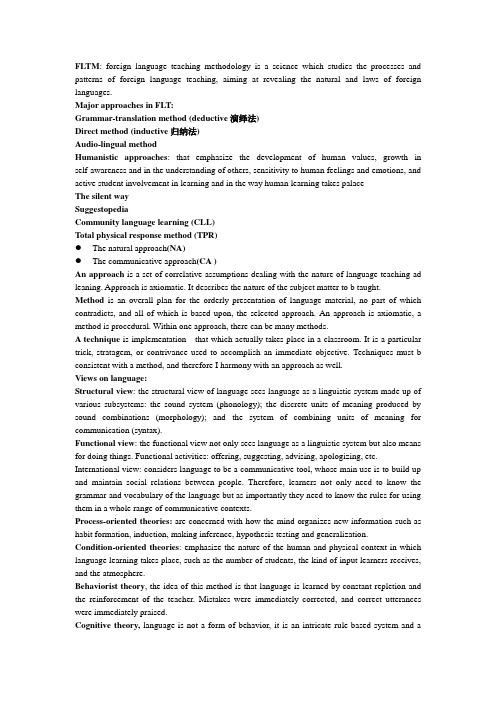
FLTM: foreign language teaching methodology is a science which studies the processes and patterns of foreign language teaching, aiming at revealing the natural and laws of foreign languages.Major approaches in FLT:Grammar-translation method (deductive演绎法)Direct method (inductive归纳法)Audio-lingual methodHumanistic approaches: that emphasize the development of human values, growth in self-awareness and in the understanding of others, sensitivity to human feelings and emotions, and active student involvement in learning and in the way human learning takes palaceThe silent waySuggestopediaCommunity language learning (CLL)Total physical response method (TPR)●The natural approach(NA)●The communicative approach(CA )An approach is a set of correlative assumptions dealing with the nature of language teaching ad leaning. Approach is axiomatic. It describes the nature of the subject matter to b taught.Method is an overall plan for the orderly presentation of language material, no part of which contradicts, and all of which is based upon, the selected approach. An approach is axiomatic, a method is procedural. Within one approach, there can be many methods.A technique is implementation---that which actually takes place in a classroom. It is a particular trick, stratagem, or contrivance used to accomplish an immediate objective. Techniques must b consistent with a method, and therefore I harmony with an approach as well.Views on language:Structural view: the structural view of language sees language as a linguistic system made up of various subsystems: the sound system (phonology); the discrete units of meaning produced by sound combinations (morphology); and the system of combining units of meaning for communication (syntax).Functional view: the functional view not only sees language as a linguistic system but also means for doing things. Functional activities: offering, suggesting, advising, apologizing, etc. International view: considers language to be a communicative tool, whose main use is to build up and maintain social relations between people. Therefore, learners not only need to know the grammar and vocabulary of the language but as importantly they need to know the rules for using them in a whole range of communicative contexts.Process-oriented theories: are concerned with how the mind organizes new information such as habit formation, induction, making inference, hypothesis testing and generalization.Condition-oriented theories: emphasize the nature of the human and physical context in which language learning takes place, such as the number of students, the kind of input learners receives, and the atmosphere.Behaviorist theory, the idea of this method is that language is learned by constant repletion and the reinforcement of the teacher. Mistakes were immediately corrected, and correct utterances were immediately praised.Cognitive theory, language is not a form of behavior, it is an intricate rule-based system and alarge part of language acquisition is the learning of this system.Constructivist theory, believes that learning is a process in which the learner constructs meaning based on his/her own experiences and what he/she already knows.Socio-constructivist theory, similar to constructivist theory, socio-constructivist theory emphasizes interaction and engagement with the target language in a social context based on the concept of “Zone of Proximal Development” (ZPD) and scaffolding.Ethic devotion, professional qualities and personal stylesCLT: communicative language teachingTBLT: task-based language teachingThe goal of CLT is to develop students’communicative competence, which includes both the knowledge about the language and the knowledge about how to use the language appropriately in communicative situations. P16Hedge discusses five main components of communicative competence: linguistic competence, pragmatic competence, discourse competence, strategic competence, and fluency.Howatt proposes a weak and a strong version of CLT.Weak version: learners first acquire language as a structural system and then learn how to use it in communication. --- the weak version regards overt teaching of language forms and functions as necessary means for helping learners to develop the ability to use them for communication.Strong version: language is acquired through communication. The learners discover the structural system in the process of leaning how to communicate.---regards experiences of using the language as the main means or necessary conditions for learning a language as they provide the experience for learners to see how language is used in communication.Communicative activities: P24Tasks are activities where the target language is used by the leaner for a communicative purpose (goal) in order to achieve an outcome.Four components of a task: a purpose, a context, a process, and a productTasks focus on the complete act of communication. (Purposeful & contextualized communication). Exercises focus the students’attention on the individual aspects of language, such as vocabulary, grammar or individual skills. (Focus on individual language items) Exercise-task comes halfway between tasks and exercises, consists of contextualized practice of language item.PPP: for teaching a new structure-based lesson, content lesson, presentation (introduces new vocabulary and grammatical structures), practice (the lesson moves from controlled practice to guided practice and exploitation of the texts when necessary) and production(the students are encouraged to use what they are learned and practiced to perform communicative tasks)The importance of lesson planning: 1. an unprepared teacher begins of a disastrous lesson.2. An unprepared teacher receives less trust and cooperation from the students. 3. The students are different, the time is different, and the mood is different.Lesson Planning: is a framework of a lesson in which teachers make advance decisions about what they hope to achieve and how they would like to achieve it. In other words, teachers need to think about the aims to be achieved, materials to be covered, activities to be organized, and techniques and resources to be used in order to achieve the aims of the lesson.Principles for good lesson planning: aim, variety, flexibility, learnability, and linkage. Variety: planning a number of different types of activities and where possible,introducing students to a wide selection of materials so that learning is always interesting, motivating and never monotonous for the students.Flexibility: preparing some extra and alternative tasks and activities at the class does not always go according to the plan so that teachers always have the option to cope with the unexpected situations rather than being the slaves of written plans or one methodology. Learnability:within capability of the students, not be too easy or beyond or below the students’ coping ability.Linkage: easy task followed by a comparatively difficult one, or do a series of language-focused activities to get the students prepared linguistically.Components of a lesson planning: background information, teaching aims, language content and skills, stages and procedures, teaching aids, assignments, and teacher’s after-lesson reflection.For skill-oriented lesson, focusing on developing skills, the model is applicable---pre-(reading), while-, post-. (Pre-step, while-step, post-step)Classroom management is the way teachers organize what goes on in the classroom.The role of the teacher: controller, assessor (evaluator, correcting mistakes and organizing feedback), organizer (organize and design task that students can perform in the class), prompter推动者(give appropriate prompts and give hints), participant, resource-provider, teacher’s new roles.There are rules to follow for making instructions effective.●The first is to use simple instructions and make them suit the comprehensive level of thestudents.●The second rule is to use the mother-tongue only when it is necessary.●Give students time to get used to listening to English instructions and help the make an effortto understand them.●Use body language to assist understanding and stick to it each time you teach the class. Student grouping: whole class group—same activity at the same rhythm and pace, lockstep, pair work, group work, individual studyDiscipline: refers to a code of conduct which binds a teacher and a group of students together so that learning can be more effective.Questioning in the classroom:Classification of question types: 1.closed questions and open questions 2.display questions and genuine questions 3.lower-order questions and higher-order questions 4.taxonomyClosed questions refer to those with only one s ingle correct answer while open questions may invite many different answers.Display questions are those that the answers are already known to the teacher and they are used for checking if students know the answer, too. Genuine questions are questions which are used to find out new information and since they often reflect real context, they are more communicative. Lower-order questions refer to those that simple require recalling of information or memorization of facts while higher order questions require more reasoning, analysis, and evaluation.Simple question and difficult questionA mistake refers to a performance error that is either a random guess or an “a slip of tongue”, it’s a failure performance to a known system.An error has direct relation with the learners’language competence. Results from Lack of knowledge in the target language. Language error cannot be self-corrected no matter how much attention is paidDealing with spoken errors: tasks or activities are focusing on accuracy or fluency. Balance between accuracy-based activities and fluency-based activities..When to correct: fluency work---not to interrupt, after the student’s performance; accuracy work---need to intervene moreHow to correct: direct teacher correction, indirect teacher correction, self-correction, peer correction, whole class correction.Goal of teaching pronunciation:Consistency: the pronunciation should be smooth and naturalIntelligibility: the pronunciation should be understandable t o the listenersCommunicative efficiency: the pronunciation should help convey the meaning that is intended by the speaker.Aspects of pronunciation: besides sounds and phonetic symbols, such as stress (strong and weak form, word stress and sentence stress), intonation and rhythm (variation).Perception practice: using minimal pairs, which order, same or different? Odd and out, Completion.Production practice: listen and repeat, fill the blanks, make up sentences, use meaningful context, use picture, use tongue twisters.Grammar presentation: The deductive method, the inductive method, the guided discovery methodGrammar practice: mechanical practice and meaningful/ communicative practice.Mechanical practice: involves activities that are aimed at form accuracy. Students pay repeated attention to a key element in a structure. Substitution drill and transformation drills.Meaningful practice: focus on the production, comprehension or exchange of meaning though the students keep an eye on the way newly learned structures are used in the process. It comes after mechanical practice. (Comparatives and superlatives). Using picture prompts, using mimes or gestures as prompts, using information sheet as prompts, using key phrases or key words as prompts, using chained phrases for story telling, using created situations.What does knowing a word involve? Denotative meaning; connotative meaning; chunk/collocations; synonyms, antonyms and hyponyms; receptive and productive vocabulary.Denotative meaning of a word or a lexical item refers to those words that we use to label things as regards real objects, such as a name or a sign, etc. in the physical world. Primary meaning of a word.A connotative meaning of a word refers to the attitudes or emotions of a language user in choosing a word and the influence of these on the listener or reader’s interpretation of the word.Collocations refer to words that co-occur with high frequency and have been accepted as ways for the use of words. For instance, see, look at, watch.Hyponyms refer to words which can be grounded together under the same superordinate concept. Receptive/passive vocabulary refers to words that one is able to recognize and comprehend in reading or listening but unable to use automatically in speaking or writing. Those words that one is not only able to recognize but also able to use in speech and writing are considered as one’s productive/active vocabulary.Ways of presenting vocabulary: inductive and deductive.Ways of consolidating vocabulary: labeling; spot the difference; describe and draw; play a game; use words series; word bingo; word association; finding synonyms and antonyms; categories; using word net-work; using the internet resources for more ideas.Developing vocabulary learning strategies: review regularly, guess meaning from context, organize vocabulary effectively, use a dictionary, and manage strategy use.Principles and models for teaching listening: focus on process, combine listening with other skills (listening can be practice with not-taking, and answers, role plays, retelling, interviewing, discussions, or a writing task), focus on the comprehension of meaning, grade difficulty level appropriately, principles for selecting and using listening activities.Two approaches are frequently used to describe different processes of listening.Bottom-up model and Top-down model.Bottom-up model: 从细节入手start with sound and meaning recognitions. Listeners construct meaning of what they hear based on the sound they hear, expect the listeners have a very effective short-term memory as they have to make sense of every sound in order to figure out the meaning of words, phrase, and structures. If there are unfamiliar sounds, listeners will find it very difficult to keep up with speaker. ---recognizing sounds of words, phrases or structures.Top-down model: 着重概要listening for gist and making use of the contextual clues and background knowledge to construct meaning are emphasized. Listeners can understand better if they already have some knowledge in their mind about the topic. Such knowledge is also termed as prior knowledge or schematic knowledge---mental frameworks for various things and experience we hold in our long-term memory. ---referring meaning from broad contextual clues and background knowledge.Three teaching stages: pre-listening—warming up; while-listening---listening comprehension; post-listening---checking answers.Teaching speakingLess complex syntax, short cuts, incomplete sentences, devices such as fillers, hesitation device to give time to thinking before speaking, false start, spontaneous, time-constraint.Types of speaking: pre-communicative activities—mechanical activities; communicative activities---meaningful activities.Controlled activities, semi-controlled activities, communicative activities:Information-gap activities; dialogues and role-plays; activities using pictures; problem-solving activities; change the story; human scrabbleOrganizing speaking tasks: use small group workTeaching readingThe construction of meaning from a printed or written message.Two broad levels in the act reading.1). A recognition task of perceiving visual signals from the printed page through the eyes.2). A cognitive task of interpreting the visual information revealing the received information with the reader’s own general knowledge, and reconstructing the meaning that the writer had meant to convey.For teaching: intensive/extensive readingIn terms of methods: skimming/scanning/predictingFor reading practice: reading aloud/silent readingThe role of vocabulary in reading: sight vocabulary: words that one is able to recognize immediately are often referred to as sight vocabulary.Principles and models for teaching reading: bottom-up model; top-down model; interactive modelPre-reading activities: predicting (predicting based on the tile/ based on vocabulary/based on the T/F questions) setting the scene, skimming, and scanningWhile-reading activities: TD (a transition device)Reading comprehension questions: 1. questions of literal comprehension 2. Questions involving reorganization or reinterpretation 3. Questions for inference (what is implied but not explicitly stated) 4. questions for evaluation or appreciation (making judgment about what the writer is trying to do and how successful he/she is in achieving his/her purpose) 5. Questions for personal responseIntensive reading is an accuracy-oriented activity involving reading for detail; the main purpose is to learn language embedded in the reading texts, which are usually short. Extensive reading is a fluency activity. The main purpose is to achieve global understanding. Te reading texts usually contains less new vocabulary and is longer than those intended for intensive reading.Teaching writingWriting for consolidating language, writing for communication, between writing for learning and writing for communication, imaginationNot have a real communicative purpose; for language skill; a little bit communicative; communicative approach; neither restrictions in contents nor in word limit; more communicative; more motivatedCA: communication approachA Productive approach to writing 成果法/a prose model approach---fruitlessA Process approach to writing 过程法: The teacher provides to guide students through the process that they undergo when they are writing. This kind of guidance should be gradually withdrawn so that the students can finally become independent writers.Main procedures of process writing include: creating a motivation to write, brainstorming, mapping, freewriting, outlining, drafting, editing, revising, proofreading and conferencing.。
英语教学法复习资料
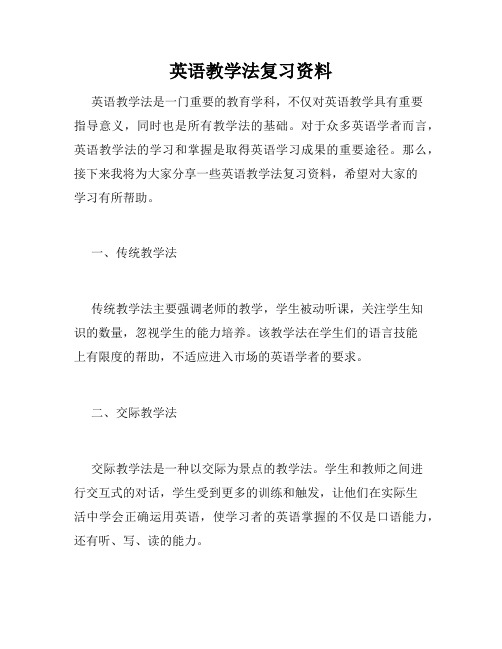
英语教学法复习资料英语教学法是一门重要的教育学科,不仅对英语教学具有重要指导意义,同时也是所有教学法的基础。
对于众多英语学者而言,英语教学法的学习和掌握是取得英语学习成果的重要途径。
那么,接下来我将为大家分享一些英语教学法复习资料,希望对大家的学习有所帮助。
一、传统教学法传统教学法主要强调老师的教学,学生被动听课,关注学生知识的数量,忽视学生的能力培养。
该教学法在学生们的语言技能上有限度的帮助,不适应进入市场的英语学者的要求。
二、交际教学法交际教学法是一种以交际为景点的教学法。
学生和教师之间进行交互式的对话,学生受到更多的训练和触发,让他们在实际生活中学会正确运用英语,使学习者的英语掌握的不仅是口语能力,还有听、写、读的能力。
三、任务教学法任务教学法强调学生要作出自己的决策,在老师的指导下进行任务。
这种教学法强调学生的技能和能力的发展,采用任务和生活场景,培养学生的英语运用能力。
四、建构主义教学法建构主义教学法主要强调学生从自己的角度去理解和掌握知识,让学习者主动地采取一定的观点和各种方法去理解和掌握知识。
学生采用的是他们自己的这些经验、观点和知识来处理和整理材料。
以上四点只是英语教学法中的一些例子,教学法的种类是无限的。
教师可以很好的结合各种教学法进行教学,以使学生的英语知识和学习方式更加全面和多样化。
总之,要成为一个出色的英语教师或者学者,我们需要了解和掌握多种教学法,以此融会贯通,结合自己的教学实践,创造出一种深入人心,适合学生需要的英语阅读、写作、听力、口语教学方案。
希望本文所分享的英语教学法复习资料能够帮助大家更好的学习和掌握英语教学法。
英语教学法复习重点

1.Views on language: a. Structural view(结构主义) b. Functional view(交际法) c. Interactional view(交往法)1) The structural view结构主义观点:language as a linguistic system made up of various subsystems: from phonological, morphological, lexical, etc. to sentences. Each language has a finite number of such structural items.To learn a language means to learn these structural items so as to be able to understand and produce language.2)The functional view交际法的观点language as a linguistic system but also as a means for doing things. Most of our day-to-day language use involves functional activities: offering, suggesting, advising, apologizing, etc.3)The interactional view交往法的观点Language is a communicative tool, whose main use is to build up and maintain social relations between people. Learners not only need to know the grammar and vocabulary of the language but as importantly they need to know the rules for using them in a whole range of communicative contexts.The interactional view says that to know how to do what one wants to do involves also knowing whether it is appropriate to do so, and where, when and how it is appropriate to do it. In order to know this, the learner has to study the patterns and rules of language above the sentence level to learn how language is used in different speech contexts.2.The qualities of teachers教师素质:ethic devotion; professional qualities; personal styles.municative competence(交际能力组成的5部分): a. linguistic competence b. pragmatic competence c. discourse competence d. strategic competence e. fluency4. Principles of communicative language teaching: a. communication principle b. task principle c. meaningfulness principle5.classification of communicative activities(交际活动的分类): a. functional communicative activities b. social interaction activities6.The role of teacher 教师的角色:a. controller b. assessor c. organizer d. prompter e. participant f. resource-provider 7. Classroom instructions: Classroom instructions refer to the type of language teachers use to organize or guide learning. They include giving directions to tasks or activities, providing explanations to a concept or language structure, setting requirements, checking comprehension, drawing attention, motivating learners, giving feedback, and assigning homework, etc.8. students grouping: a. whole class work b. pair work c. group work d. individual study6\7\81.Three ways to show the stress pattern words, phrases and sentences:1)Use gesture;2)Use the voice;3)Use the blackboard.2.Factors contribute to successful practice:1) pre-learning 2) volume and repetition 3) success-orientation 4) heterogeneity 5) teacher assistance 6) interest3.Grammar practice is usually divided into 2 categories: mechanical practice & meaningful/communicative practice.4.Mechanical practice involves activities that aimed at form accuracy.5.What does it mean to know a word? Knowing a word mans 1) knowing its pronunciation and stress; 2) knowing its spelling & grammatical properties; 3) knowing its meaning; 4) knowing how & when to use it to express the intended meaning.9\10\111. Principles for teaching listening 1).focus on process.2).combine listening with other skills.3).focus on the comprehension of meaning.4).grade difficulty level appropriately.2. Factors that affect the difficulty level of listening tasks, but they fall into 3 main categories:1)type of language used.2)task or purpose in listening.3)context in which the listening occurs.3. Models for teaching reading:1)Bottom-up model.(2)Top-down model 3)Interactive model4.The characteristic are common in successful speaking tasks:1) Maximum foreign talk; 2)Even participation;3)High motivation;4)Right language level.5. Littlewood divides communicative speaking activities into 2 types: Communicative activities: functional communication activities and social interaction activities. It also includes Pre-communicative activities: structural activities andQuasi-communicative activities. Pre-communicative activities are intended to prepare learners for Communicative activities. 6. Pre-reading activities: predicting; setting the scene; skimming; scanning. Skimming means reading quickly to get the gist,e.g.the main idea of the text. Scanning which means to read to locate specific information.7.Some speaking activities:1)controlled activities: mainly focus on form and accuracy; 2)semi-controlled activities: focus on meaning and communication; 3)communicative activities.8. Ur points out that factors that affect the success of role-plays are: 1)the teacher’s enthusiasm;2)careful instructions;3)clear situations and roles; 4)and making sure that the students have the language they will need to carry out the role-play.1.The main procedures of process writing(过程写作)include: Creating a motivation to write; brainstorming; mapping; freewriting; outlining; drafting; editing; revising; proofreading and conferencing.2. Principles can help teachers motivate students to write: 1) Make the topic of writing as close as possible to students’ life.2) Leave students enough room for creativity and imagination. 3) Prepare students well before writing. 4) Encourage collaborative group writing as well as individual writing. 5) Provide opportunities for students to share their writings. 6) Provide constructive and positive feedback. 7) Treat students’’ errors strategically. 8) Give students a sense of achievement from time to time.1.我国英语教学的六个基本原则原先所倡导的中学英语教学的基本原则:1、交际性原则2、阶段侧重原则3、语音词汇语法综合教学原则4、使用和控制使用本族语的原则5、以学生为中心的原则。
- 1、下载文档前请自行甄别文档内容的完整性,平台不提供额外的编辑、内容补充、找答案等附加服务。
- 2、"仅部分预览"的文档,不可在线预览部分如存在完整性等问题,可反馈申请退款(可完整预览的文档不适用该条件!)。
- 3、如文档侵犯您的权益,请联系客服反馈,我们会尽快为您处理(人工客服工作时间:9:00-18:30)。
What makes a good qualified english teacher?A plan of given material.1 CLT :Communicative Language Teaching2 TBLT:Task-based Language Teaching3 PPP:Presentation,Practice and Production. 3P教学法4 Macro Planning 宏观计划It plans over a longer period of time,for instance, planning for a whole programme or a whole-year course.56 Micro planning 微观计划It plans for a specific unit or a lesson, which usually lasts from one to two weeks or forty to fifty minutes respectively.7 The guided discovery method 指导发现法It is similar to the inductive method in that the students are induced to discover rules by themselves but different in that the process of the discovery is carefully guided and assisted by the teacher and the rules are then elicited and taught explicitly.8 Implicit knowledgeIt refers to knowledge that unconsciously exists in our mind,which we can make use of automatically without making any effort.9 Explicit KnowledgeIt refers to our conscious knowledge about the language.10 Bottom-up model 自上而下/文本驱动模式The way teaches reading always reflects the way one understands reading and the reading process.11 Top-down model 图示驱动模式One's background knowledge plays a more important role than new words and new structures in reading comprehension.12 Interactive model 交互模式The current theory views reading as an interactive process. That is to say,the brain receives visual information and at the same time, interprets or reconstructs the meaning the writer had in mind when he wrote the text.13 AssessmentIt involves the collecting of information or evidence of a leaner's learning progress and achievement over a period of time for the purposes of improving teaching and learning.14 Sight Vocabulary 即识词汇Words that one is able to recognise immediately are often referred to as sight vocabulary.In other words, your sight vocabulary will be those words that you can recognise with both sounds and meanings without special effort from your brain.15 Information Gap信息沟16 Portfolio学习文件夹成长记录袋It is a purposeful collection of materials assembled over a period of time by a learner to provide evidence of skills,abilities and attitudes related to their study.17 Mechanical PracticeIt involves activities that are aimed at form accuracy.18 Meaningful PracticeIt focus on the production,comprehension or exchange of meaning though the students ' keep an eye on ' the way newly learned structures are used in the process.19 Criterion-referenced assessmentCriterion-referenced language assessment is based on a fixed standard or a set criterion.20 Norm-referenced assessmentIt is designed to measure how the performance of a particular student or group of students compares with the performance of another students or group of students whose scores are given as the norm.21 On -the-use evaluationIt means the evaluation which is carried out independent of its users or before it gets into the classroom.22 In-the-use evaluationFor in-the-use evaluation,evaluation is done based on the user's opinions about how useful and effective it is for promoting learning.1 What is the communicative competence?It includes both the knowledge about the language and the knowledge about how to use the language appropriately in communicative situations.2 Principles of CLTmunicative principle:Actives that involve real communication promote learning.B.Task principle:Activities in which language is used for carrying out meaningful tasks promote learning.C. Meaningfulness principle: language that is meaningful to the learner supports the learning process.3 The 6 orientation for evaluating the communicative classroom acting.A. Communicative purpose:The activity must involve the students in performing a real communicative purpose rather than just practising language for its own sake. 目的B. Communicative desire:The activity must create a desire to communicate in the students. 交际欲望C. Content,not form:When the students are doing the activity, they must be concentrating on what they are saying,not how they say it.有内容,不是考虑形式D. Variety of language: The activity must involve the students in using a variety of language,not just one specific language form.E. No teacher intervention:The activity must be designed to be done by the students working by themselves rather than with the teacher.干涉F. No materials control: The activity should not be designed to control what language the students should use.4 Four components of the taskA. A purpose: making sure the students have a reason for undertaking the taskB. A contact: this can be real,simulated or imaginary,and involves sociolinguistic issues such as the location, the participants and their relationship,the time,and other important factorsC. A process:getting the students to use learning strategies such as problem solving reasoning,inquiring, conceptualising and communicating.D. A product: there will be some form of outcome, either visible or invisible.5 Principles for good lesson planningA. Aim. It means the realistic goals for the lesson.B. Variety. It means planning a number of different types of activities and where possible,introducing students to a wide selection of materials so that learning is always interesting,motivating and never monotonous for the students.C. Flexibility. It means preparing some extra and alternative tasks and activities so that teachers have the options to cope with the unexpected situations rather than being the slaves of written plans or one methodology.D. Learnability. It means the contents and tasks planned for the lesson should be within the learning capability of the students.E. Linkage. It means the stages and steps within each stage are planned in such a way that they are someway linked with one another.6 Measures for indisciplined actsA. Act immediately. If possible, indisciplined acts should be immediately stopped so that less damage is made.B. Stop the class. If the indiscipline hinder the progress of the whole class, the teacher should stop the class and make it clear what is wrong.C. Rearrange the seats. If students are moved to the front of the class they will behave better.D. Change the activity.E. Talk to students after class. If a student is continually making trouble, the teacher should talk to that student after class.F. Create a code of behaviour. It means the teacher and students can work together to create some basic rules for the class during activities.7 How to deal with errorsA. Make a distinction between an error and a mistake. A mistake refers to a performance error that is either a random guess or a ' slip of tongue ', and it is a failure performance to a known system. An error has direct relation with the learners' language competence.B. Dealing with spoken errorsC. Choose proper time to correctD. How to correct. Avoid damaging students' self esteem and confidence.8 Goal of teaching pronunciationA. Consistency:the pronunciation should be smooth and natural.B. Intelligibility:the pronunciation should be understandable to the listeners.C. Communicative efficiency:the pronunciation should help convey the meaning that is intended by the speaker.9 What does it mean to know a word.A. It means knowing its pronunciation and stressB. Knowing its spelling grammatical propertiesC. Knowing its meaningD. Knowing how and when to use it to express the intended meaning.10 Ways of presenting vocabularyA. Try to provide visual or physical demonstration whenever possible, using pictures, photos, video clips, mime or gestures to show meaning.B. Provide a verbal context to demonstrate meaning.C. Use synonyms or antonyms to explain meanings.D. Use lexical sets or hyponyms to show relations of words and their meanings.E. Translate and exemplify,especially with technical words or words with abstracts meaning.F. Use word formation rules and common affixes to build new lexical knowledge on what is already known.G. Teach vocabulary in chunks.H. Think about the context in real life where the word might be used.I. Think about providing different context for introducing new words.J. Prepare for possible misunderstanding or confusion that students may have.11 Principles for teaching speakingA. Balancing accuracy-based with fluency-based practices.B. Contextualising practiceC. Personalising practiceD. Building up confidenceE. Maximising meaningful interactionsF. Helping students develop speaking strategiesG. Making the best use of classroom learning environment to provide sufficient language input and practice for the students12 The main procedures of process writingA. Creating a motivation to writeB. Brainstorming,C. MappingD. FreewritingE. OutliningF. DraftingG.editingH. RevisingI. ProofreadingJ.conferencing13 Methods for assessmentA. Summative and formative assessmentB. Teacher's observationsC. Continuous assessmentD. Self-assessment and peer assessmentE. Project work学习日志F. Portfolios学习文件夹成长记录袋14 intelligence。
